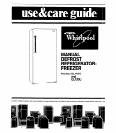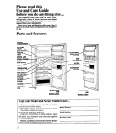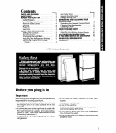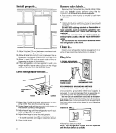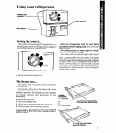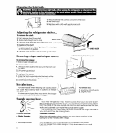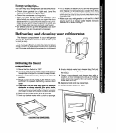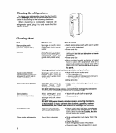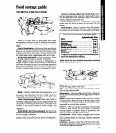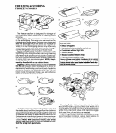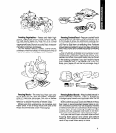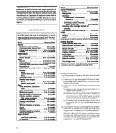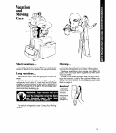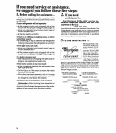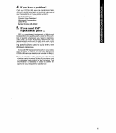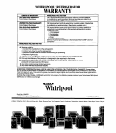
Food storage guide
STORING FRESH FOOD
There is a right way to package and store
refrigerated or frozen foods. To keep foods fresher,
longer, ta ke the time to study these recommended
steps.
leafy Vegetables...Remove store wrapping
and trim or tear off bruised and discolored areas.
Wash in cold water and drain. Place in plastic bag
or plastic containerand store in crisper. Cold, moist
air helps keep leafy vegetables fresh and crisp.
Vegetables with Skins (carrots, peppers)...Store
in crisper, plastic bags or plastic container.
Fruit...Wash, let dry and store in refrigerator in
plastic bags or crisper. Do not wash or hull berries
until they are ready to use. Sort and keep berries in
their store container in a crisper, or store in a
loosely closed paper bag on a refrigerator shelf.
Meat*
. ..Meat is perishable and expensive...you
won’t wantto waste an ounce of it through careless
handling. The following list and chart give you
packaging hints and time limits.
Fresh, Prepackaged Meat. Store fresh meat in
the store wrapping. Vacuum packaged meat can
be frozen for as long as one month if the seal is not
broken. If you want to keep it frozen longer, you
should wrap it with special freezer wrapping
material.
Fresh Meat, Not Prepackaged. Remove the
market wrapping paper and re-wrap in aluminum
foil for storing it unfrozen.
Cooked Meat. Wrap or cover cooked meat with
plastic wrap or aluminum foil. Store immediately.
Cured or Smoked Meat and Cold Cuts. Ham,
bacon, sausage, cold cuts, etc., keep best in origi-
nal wrappings. Once opened, tightly re-wrap in
plastic wrap or aluminum foil.
Canned Ham. Store in refrigerator unless the
label says it’s okay to store on the shelf. Do not
freeze.
Fresh Poultry...Wrap in plastic wrap. The plaStiC
on poultry, as purchased, may be used for storage.
STORAGE CHART FDR FRESH AND CURED MEAT*
WLpe
Approximate Time
(days)
Varlefy Meals . . . . . . . . . . . . . . . . . . . . . . .
Chlcken
. . . . . . . . . . . . . . . . . . . . . . . . . . . .
: ;f
GroundBeef . . . . . . . . . . . . . . . . . . . . . . . . lto2
SfeaksandRoasfs
. . . . . . . . . . . . . . . . . . 3to5
CuredMeats . . . . . . . . . . . . . . . . . . . . . . . .
Bacon
. . . . . . . . . . . . . . . . . . . . . . . . . . . . . .
‘5to;O
cold cut,
. . . . . . . . . . . . . . . . . . . . . . . . . . .
3to5
‘If meat Is to be stored longer than the tlmes glven,
follow the dlrectlons for freezlna.
NOTE: Fresh fish and shellfish should be used the
same day as purchased.
Eggs...Store without washing in the original carton
or use the egg nest in the door.
Milk...Wipe milk cartons. For best storage, place
milk on top interior shelf.
Beverages...Wipe bottles and cans. Store on
lower door shelves beneath the egg nest or interior
shelves.
Butter...Store daily needs on serving dish in butter
compartment. When storing an extra supply, wrap
in air-tight packaging and store in freezer com-
partment or on top door shelves.
Cheese...Store in original wrapping until you are
ready to use. Once the package is opened,
rewrap tightly in plastic wrap or aluminum foil.
Store on interior refrigerator shelves.
Condiments...Store catsup, mustard, jelly, olives,
pickles, etc. on door shelves. NOTE: Store bottled
and canned items on the door shelves beneath
the egg nest.
Leftovers...Always cover the container with plas-
tic wrap or aluminum foil to keep food from drying.
Store on refrigerator shelves.
9



